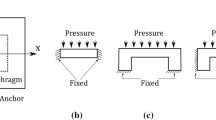Abstract
Design and modeling of microelectromechanical system (MEMS)-based piezoresistive pressure sensor are main requirements to fabricate application-oriented pressure sensor devices for the industry, i.e., nuclear power plants, aerospace and avionics, oil and gas, Internet of Things, wearable electronics and consumer electronics. In this research work, analytical modeling is presented to estimate the overall sensitivity of the MEMS technology-based piezoresistive pressure sensor. The sensitivity of a piezoresistive pressure sensor is estimated using the thin plate theory and the theory of piezoresistivity in silicon. The mechanical responses of a thin plate in terms of deflection and induced stresses are presented and discussed. The effects of geometrical parameters on deflection and induced stresses are analyzed using a ratio of half-edge length with the thickness (\(a/h\)) and a ratio of diaphragm edges (\(a/b\)). These ratio parameters are responsible for the sensitivity of the piezoresistive pressure sensor. Moreover, a comparative assessment is presented for the current model with a model available in the literature. Further, calculations of average stresses are carried out for the piezoresistor geometry of a small rectangular area. Thereafter, a quantitative variation in the calculated sensitivity is presented based on calculation with maximum stress and average stress. The calculated difference in overall sensitivity is found to be 3%. However, a significant reduction in average stresses as compared to maximum induced stresses is obtained as 28% and 36% change for stress X and stress Y, respectively.














Similar content being viewed by others
References
Barlian, A.A., et al.: Review: semiconductor piezoresistance for microsystems. Proc. IEEE 97(3), 513–552 (2009). https://doi.org/10.1109/jproc.2009.2013612
Eaton, W.P., Smith, J.H.: Micromachined pressure sensors: review and recent developments. Smart Mater. Struct. 6(5), 530–539 (1997). https://doi.org/10.1088/0964-1726/6/5/004
Kraft, M., White, N.M.: Mems for Automotive and Aerospace Applications (2013)
Fragiacomo, G., Reck, K., Lorenzen, L., Thomsen, E.V.: Novel designs for application specific MEMS pressure sensors. Sensors (Basel) 10(11), 9541–9563 (2010). https://doi.org/10.3390/s101109541
Belwanshi, V., Philip, S., Topkar, A.: Experimental study of gamma radiation induced degradation of a piezoresistive pressure sensor. Microsyst. Technol. 24, 3299–3305 (2018)
Jindal, S.K., Raghuwanshi, S.K.: A complete analytical model for circular diaphragm pressure sensor with freely supported edge. Microsyst. Technol. 21, 1073–1079 (2015). https://doi.org/10.1007/s00542-014-2144-5
Jindal, S.K., Magam, S.P., Shaklya, M.: Analytical modeling and simulation of MEMS piezoresistive pressure sensors with a square silicon carbide diaphragm as the primary sensing element under different loading conditions. J. Comput. Electron. 17(4), 1780–1789 (2018)
Belwanshi, V., Topkar, A.: Quantitative analysis of temperature effect on SOI piezoresistive pressure sensors. Microsyst. Technol. 23(7), 2719–2725 (2017). https://doi.org/10.1007/s00542-016-3102-1
Varma, M.A., Thukral, D., Jindal, S.K.: Investigation of the influence of double-sided diaphragm on performance of capacitance and sensitivity of touch mode capacitive pressure sensor: numerical modeling and simulation forecasting. J. Comput. Electron. 16(3), 987–994 (2017)
Belwanshi, V., Topkar, A.: Quantitative analysis of MEMS piezoresistive pressure sensors based on wide band gap materials. IETE J. Res. (2019). https://doi.org/10.1080/03772063.2019.1620641
Kumar, S.S., Pant, B.D.: Effect of piezoresistor configuration on output characteristics of piezoresistive pressure sensor: an experimental study. Microsyst. Technol. 22, 709–719 (2016). https://doi.org/10.1007/s00542-015-2451-5
Kumar, S.S., Pant, B.D.: Polysilicon thin film piezoresistive pressure microsensor: design, fabrication and characterization. Microsyst. Technol. 21, 1949–1958 (2015). https://doi.org/10.1007/s00542-014-2318-1
Li, C., Cordovilla, F., Ocaña, J.L.: Design optimization and fabrication of a novel structural piezoresistive pressure sensor for micro-pressure measurement. Solid State Electron. 139, 39–47 (2018). https://doi.org/10.1016/j.sse.2017.09.012
Bhat, K.N.: Silicon micromachined pressure sensors. J. Indian Inst. Sci. 87(1), 115–131 (2007)
Singh, K., Joyce, R., Varghese, S., Akhtar, J.: Fabrication of electron beam physical vapor deposited polysilicon piezoresistive MEMS pressure sensor. Sens. Actuators A Phys. 223, 151–158 (2015). https://doi.org/10.1016/j.sna.2014.12.033
Akhtar, J., Dixit, B.B., Pant, B.D., Deshwal, V.P.: Polysilicon piezoresistive pressure sensors based on mems technology. IETE J. Res. 49(6), 365–377 (2003). https://doi.org/10.1080/03772063.2003.11416360
Timoshenko, S.P., WoinowskyKrieger, S.: Theory of plates and shells. McGraw-hill, London (1959)
Bao, M.: Analysis and Design Principles of MEMS Devices. Elsevier, Amsterdam (2005)
Minhang, B., Wang, Y.: Analysis and design of a four-terminal silicon pressure sensor at the centre of a diaphragm. Sensors and Actuators 12(1), 49–56 (1987). https://doi.org/10.1016/0250-6874(87)87005-1
Love, A.E.H.: The Mathematical Theory of Elasticity, vol. 4. Dover, New York (1944)
Gong, S.C., Lee, C.: Analytical solutions of sensitivity for pressure microsensors. IEEE Sens. J. 1(4), 340 (2001). https://doi.org/10.1109/7361.983474
Acknowledgement
The author thanks Dr. Anita Topkar, Prof. D.S. Patil, Prof. Udayan Ganguly and Dr. Tribeni Roy for the continuous guidance and fruitful discussions.
Author information
Authors and Affiliations
Corresponding author
Additional information
Publisher's Note
Springer Nature remains neutral with regard to jurisdictional claims in published maps and institutional affiliations.
Rights and permissions
About this article
Cite this article
Belwanshi, V. Analytical modeling to estimate the sensitivity of MEMS technology-based piezoresistive pressure sensor. J Comput Electron 20, 668–680 (2021). https://doi.org/10.1007/s10825-020-01592-5
Received:
Accepted:
Published:
Issue Date:
DOI: https://doi.org/10.1007/s10825-020-01592-5




